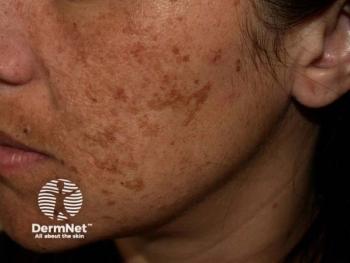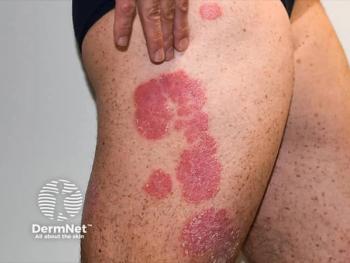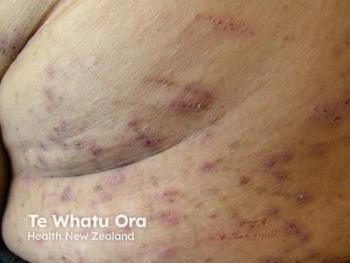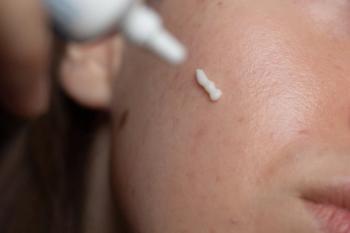
A Rheum With a View at DERM 2025: Looking at Cutaneous Lupus
Key Takeaways
- CLE primarily affects women, with acute CLE often linked to systemic lupus and chronic CLE rarely progressing to systemic lupus.
- Nonpharmacologic management includes photoprotection, smoking cessation, and vitamin D supplementation to support patients with CLE.
Rheumatologist Karim Ladak, MD, shared diagnostic and treatment tips for cutaneous lupus at DERM 2025.
Recognizing the differences between the 3 subtypes of
“We’ve all heard of lupus. This is a systemic autoimmune disease that primarily affects women of childbearing age,” he told attendees. “It can affect pretty much any blood existing in your body—CNS, lungs. It can fry your kidneys, will give you inflammatory arthritis and very frequently it can affect your skin.”
Cutaneous Lupus
In general, women (especially younger women of childbearing age) are most likely to develop
Although CLE can occur alone or comorbid with systemic lupus, Ladak said the good news is that most patients with cutaneous will only be impacted by skin issues and not develop systemic lupus. In addition, the systemic disease tends to be mild.
“When you diagnose cutaneous lupus in your clinic, your patients are going to what to know, ‘Does this mean I have lupus?’ Does this mean I might lose my job and go on disability because of chronic joint pain?’ And you can immediately reassure her… that only 15% will go on to develop the systemic disease,” he said.
Acute CLE
Acute CLE (ACLE) often presents in a malar (butterfly) pattern over the nasal bridge but spares nasolabial folds; this is the localized version. Generalized ACLE is not as common as the localized ACLE; can be distributed in other areas of the body and the rash presents as bullous, morbilliform, or even Stevens-Johnson Syndrome-like. ACLE is non-scarring, meaning when the skin recovers, there are no signs of it left behind. It is almost always associated with active systemic lupus. Lab tests are positive for ANA in 80% to 90% of patients,
Subacute CLE
Subacute CLE (SCLE) presents as an annular or papulosquamous rash, and it more common among Caucasian women in reproductive years. It is nonscarring, but it does cause depigmentation. SCLE is strongly seropositive, Ladak said, with 80% testing ANA positive and 80% testing positive for anti-ro. About 50% of patients with SCLE will develop/meet criteria for SLE, but the disease is usually mild.
Approximately one-third of SCLE cases are drug-induced, with variable onset (weeks to months) following initiation of the suspect agent, Ladak said. If caught early enough, drug-induced SCLE can resolve within 3 months of discontinuing the offending agent. More than 100 agents have been identified as problematic for SCLE, including Thiazide diuretics, PPIs, antibiotics, TNF inhibitors, antifungals.
Chronic CLE
The most common form is chronic CLE (CCLE), with discoid lupus being the most common presentation. The lesions are coin-shaped, erythematous, and scaly, and have been associated with follicular plugging. Areas of the body that are sun-exposed, like the neck, face, ears, and scalp, are most likely to be impacted. Depigmentation and scarring are commonly seen. Laboratory tests usually result in ANA negative or low titer findings.
Although the presentation and healing may be the worst of the subtypes, Ladak said if he had to pick one form, he would choose CCLE because patients rarely develop systemic lupus.
Management Strategies
Nonpharmacologic management of all 3 CLEs is essential, Ladak told attendees. First and foremost, photoprotection is essential. All patients should be advised to use sunscreen, and he is even encouraged patients to use photoprotective clothing. Similarly, smoking tends to worsen CLE, so patients should be advised to abstain and/or quit.
When considering pharmacology, Ladak said the easiest way to address the issue is to think about inflammation. “We have an active disease, we have a fire, and we need to put it out,” he told attendees. “When the inflammation is live, you want to quash it, and when its quashed and quelled, you want to keep it sleeping and dormant.”
If it is active but localized and not too bad, Ladak suggested prescribing topical steroids or tacrolimus. He uses potent steroids for 2 weeks to get the disease under control. “We get it hard up front, and we get it under control and move on,” he explained.
Systemic steroids are his go-to for diffuse or severe flares. “It needs to be potent,” he told attendees. He recommended 0.5-1 mg/kg/day tapered over 4 weeks and noted a 90% response rate.
There are a few options for maintenance treatment, according to Ladak. He uses tacrolimus for localized CLE, and he suggested antimalarials like
Generally, the more common adverse events are minimal, with headache and gastrointestinal distress as the top 2, he said. However, patients must be monitored for “gray tan,” usually found in the front of the shins. Even worse, this is usually an indicator of toxicity that can also affect the eyes and may signal the patient is at risk for blindness; he suggested annual eye exams for these patients.
Methotrexate, mycophenolate, dapsone, and acitretin may be considered as second line options, with biological disease-modifying antirheumatic drugs like belimumab (Benlysta) a third line option, Ladak added.
Because some patients will progress to systemic disease, routine clinical evaluation is essential for these patients, with serologies performed at appropriate intervals.
Prognosis
“Remember, there is a low risk of progression to SLE, and it varies by subtype,” he told attendees. Ladak keeps 4 questions in mind when seeing patients with CLE:
- Are there arthritic joint pains?
- Are there symptoms like dry eyes and dry mouth?
- Is there fatigue?
- Are there oral ulcers?
“If you ask those questions, you will capture the lion share of patients with active SLE,” he said.
References
1. Ladak K. Rheum with a View: A Look at Dermatology Pearls through the Eyes of a Rheumatologist. Presented at the DERM 2025 NP PA CME Conference; July 23-26, 2025; Las Vegas, Nevada.
2. Cutillas-Marco E, Marquina-Vila A, Grant WB, Vilata-Corell JJ, Morales-Suárez-Varela MM. Lupus. 2014 Jun;23(7):615-23. doi: 10.1177/0961203314522338. Epub 2014 Feb 6. PMID: 24503020.
Newsletter
Like what you’re reading? Subscribe to Dermatology Times for weekly updates on therapies, innovations, and real-world practice tips.


















